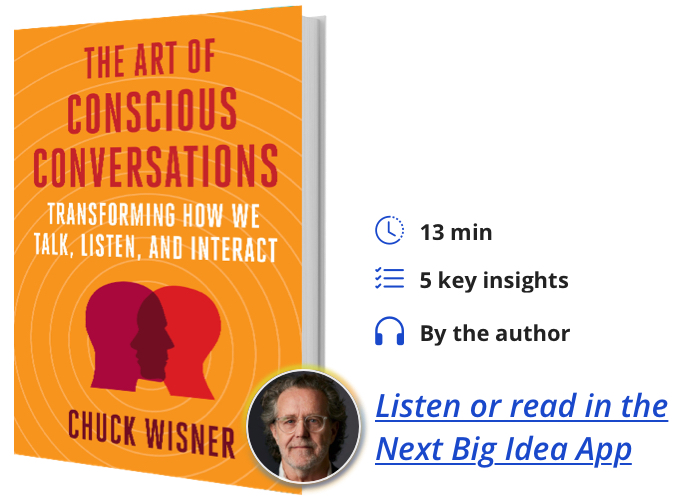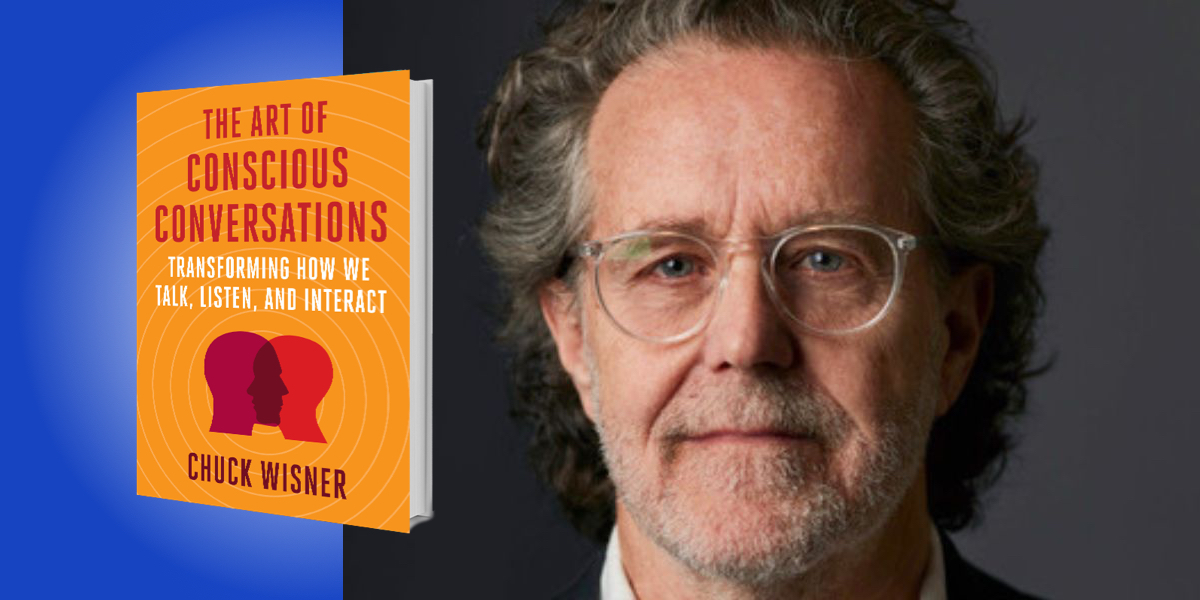Chuck Wisner is a leadership advisor, team consultant, and personal coach. He began his career as an architect, but after fifteen years in that field he switched tracks by becoming a senior affiliated mediator with the Harvard Law Mediation Program. He has since become increasingly specialized as a professional coach, and today he advises leaders at Google, Rivian, Apple, and Tesla, among others.
Below, Chuck shares 5 key insights from his new book, The Art of Conscious Conversations: Transforming How We Talk, Listen, and Interact. Listen to the audio version—read by Chuck himself—in the Next Big Idea App.

1. In conversation, you are the common denominator.
We are the common denominator, not in an arrogant or egocentric way, but as the central player. Only we can take an honest look at our emotions, reactions, and thoughts. When I’m stressed about a conversation with a sibling, impatient with a seemingly incompetent service rep, or frustrated with a colleague, I am at the center of each, and should look inside before pointing fingers at others.
The irony is that no matter the circumstances on the outside, we can only change our reactions by looking inside. Our emotions and reactions are reflections of our beliefs and thinking. When we pay attention to our conversational patterns, rather than judge them, we can note them, name them, and befriend them. With that, we have control over them. Curiously looking within ourselves guides us to rethink, reframe, and refresh future conversations.
2. Your stories aren’t the truth.
Storytelling is the primary conversation type because individuals, cultures, and societies thrive on them. They can be beautiful, entertaining, informative, and transformational. A success story is encouraging, and a funny story provokes laughter. An inspirational story can change lives. Stories serve us well—until they don’t.
They can also be limiting, judgmental, nasty, untrue, and addictive. I grew up with my grandpa saying, Stop crying, be a bigger man! As a young boy, his words had power and got stuck in my consciousness. That story lived inside me emotionally for years until I could bust it by realizing it wasn’t true and freed myself of its limitations.
“We get hooked on [opinions], identify with them, throw them about indiscriminately, and blindly defend them.”
In a millisecond beyond our conscious awareness, our big brain makes sense of all our experiences and beliefs, so voila, we have a story and auto pilot reactions. This sense-making process helps us navigate life and takes little energy, but it also narrows our life. A counter to this autopilot pattern is staying curious about our own stories to better understand them. Ask yourself: Which stories serve us and which stories harm us?
Our stories consist of facts and opinions. Facts are indisputable. This sounds easy, but consider the political mess of the last four years. Facts are crucially important because they provide a solid foundation for society.
Opinions are a much messier affair. Unlike facts, they are not grounded in truth. They reflect beliefs we adopted from our families and cultures. We know them well, and they are like a satisfying comfort food. We get hooked on them, identify with them, throw them about indiscriminately, and blindly defend them. But it is easy to speak of them as the truth.
It will take courage to answer these, but do so and these four crucial questions will guide a fresh understanding of your own opinions:
- What are my desires?
- What concerns do I have?
- Are there issues of authority/power at play?
- What standards are driving my opinion?
3. Hold your opinions with an open hand.
Another type of conversation is the collaborative conversation, where multiple stories intersect. We enter conversations with our stories in hand, and without heeding the lessons of the storytelling conversation, we forcefully advocate for our opinions as the one right or only perspective. We’re trained to be knowers, to have the answer, and to be rewarded for it. Being the knower is a dangerous leadership trap, as it is like showing up with our opinions close-fisted and ready to defend them, no matter the consequences. Not surprisingly, two closed fists create a battle, and listening becomes impossible.
“Being the knower is a dangerous leadership trap, as it is like showing up with our opinions close-fisted and ready to defend them, no matter the consequences.”
Rather than being in conversation with a closed fist, hold positions lightly with an open hand. Reveal the thinking behind an opinion and demonstrate willingness to consider opposing ideas. It takes one person to shift a stressful conversation into a collaborative one.
The four aforementioned questions also guide better understanding of others. Shifting from advocacy to open inquiry, we can ask sincere questions: What concerns do you have about the direction of the project? What do you hope to accomplish? What are your standards for success?
The humble sharing of our thinking is an invitation for others to do the same. Open hearts and minds increase listening tenfold.
4. Creative insights emerge from an open mind.
Then we have the creative conversation, which naturally flows out of productive collaborations. In these conversations, we reacquaint ourselves with our oft-forgotten right brain. The left brain, the center of logic, planning, science, and objective truths, has been dominant in most western cultures for a long time. Integrating our imaginative right brain with our logical left brain encourages us to wonder: What else might be possible?
In a design class I took thirty years ago, one of my professors gave us an assignment to present ideas about a new toy. I spent the next few days struggling to develop a brilliant idea. Finally, it struck—a moldable, light, beautiful cloud for every kid! I spent hours drawing, convinced my toy would change the world.
“Creative conversation asks us to set aside judgments, slow down, and let the ideas flow.”
I proudly presented my idea to the professor. He asked, What was the assignment? I said, To create a new toy. He said No, your job was to present many ideas for new toys. You got hooked on your first idea. Go back to your drawing board and give me ten more ideas.
I will never forget that lesson. In conversations, we make the same mistake. We tell our stories, hook onto an idea, and put it into action. Creative conversation asks us to set aside judgments, slow down, and let the ideas flow. Unforeseen and unexpected ideas bubble up through open minds and conscious conversations.
5. Make commitments you can keep—don’t rush to yes.
The fourth conversation is the commitment conversation. Life thrives on promises. Marriage, parenting, leading, selling, buying, partnering, etc., all rely on commitments. They are how we coordinate actions with others. We use commitments to satisfy our desires and concerns for the future, and we use them to solve problems.
We are steeped in commitment conversation daily, but we engage on autopilot. Autopilot is fine until we default to yes and miss asking essential questions about the design, timing, or details. An easy yes allows lots of room for misunderstandings. We make sloppy promises by being polite, making assumptions, defaulting to yes, and avoiding no. A request without a possible no is not a request but a demand.
The first best move is paying attention to your commitment conversation patterns. Note how you respond, how others make requests, and how promises go haywire. This conversation is central to success and happiness at home and work. Slow down and make thoughtful commitments. Trust will follow.
To listen to the audio version read by author Chuck Wisner, download the Next Big Idea App today:
































